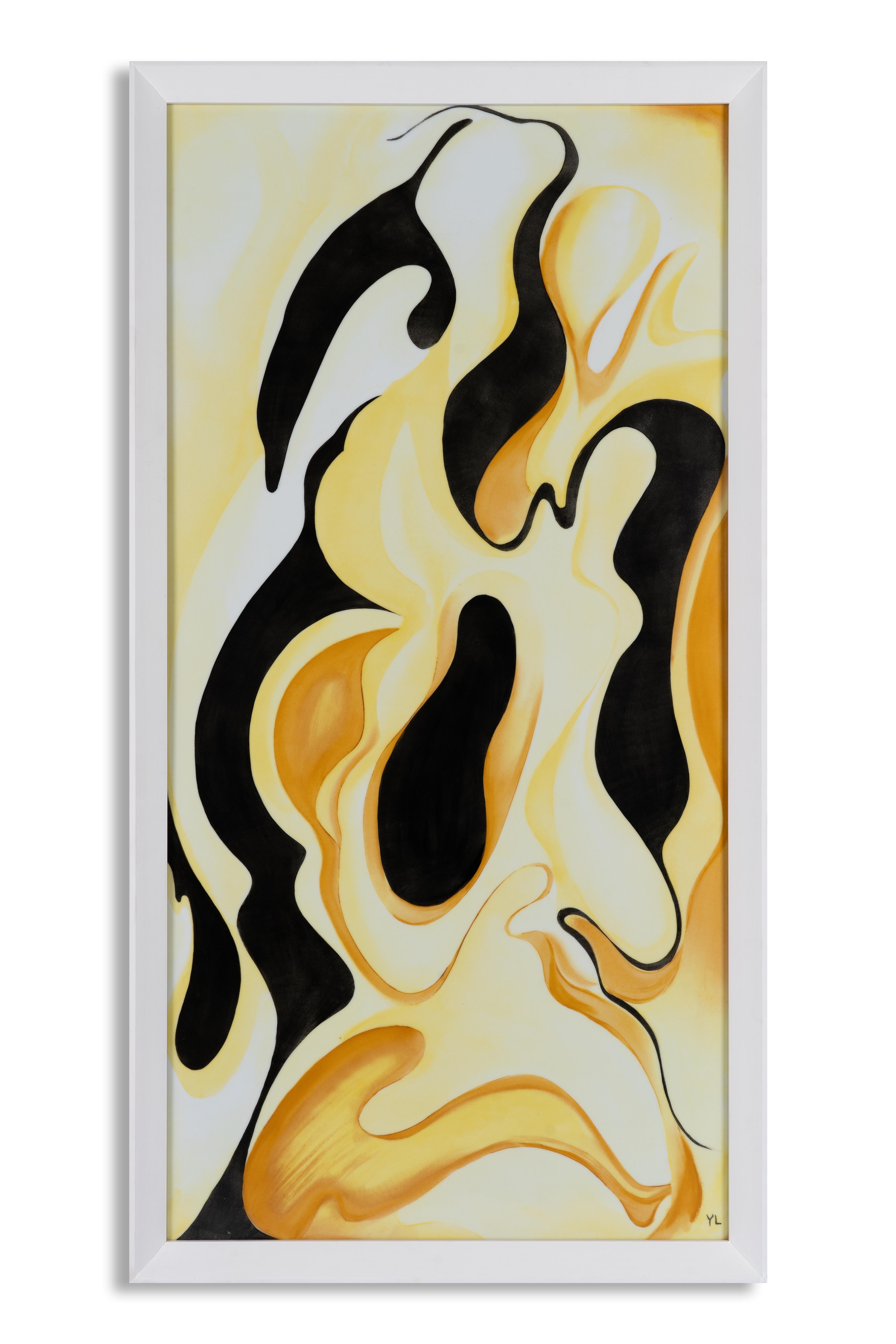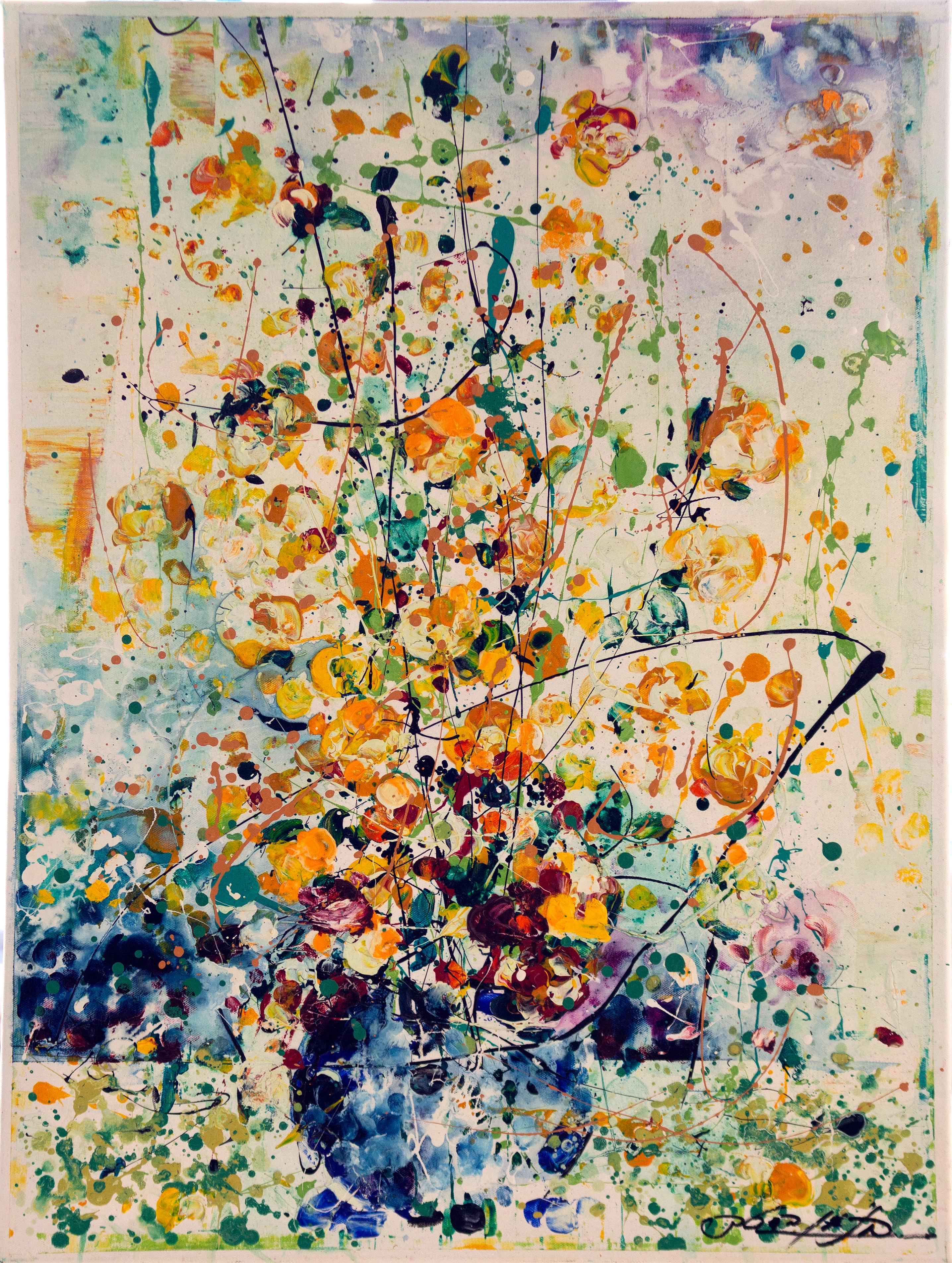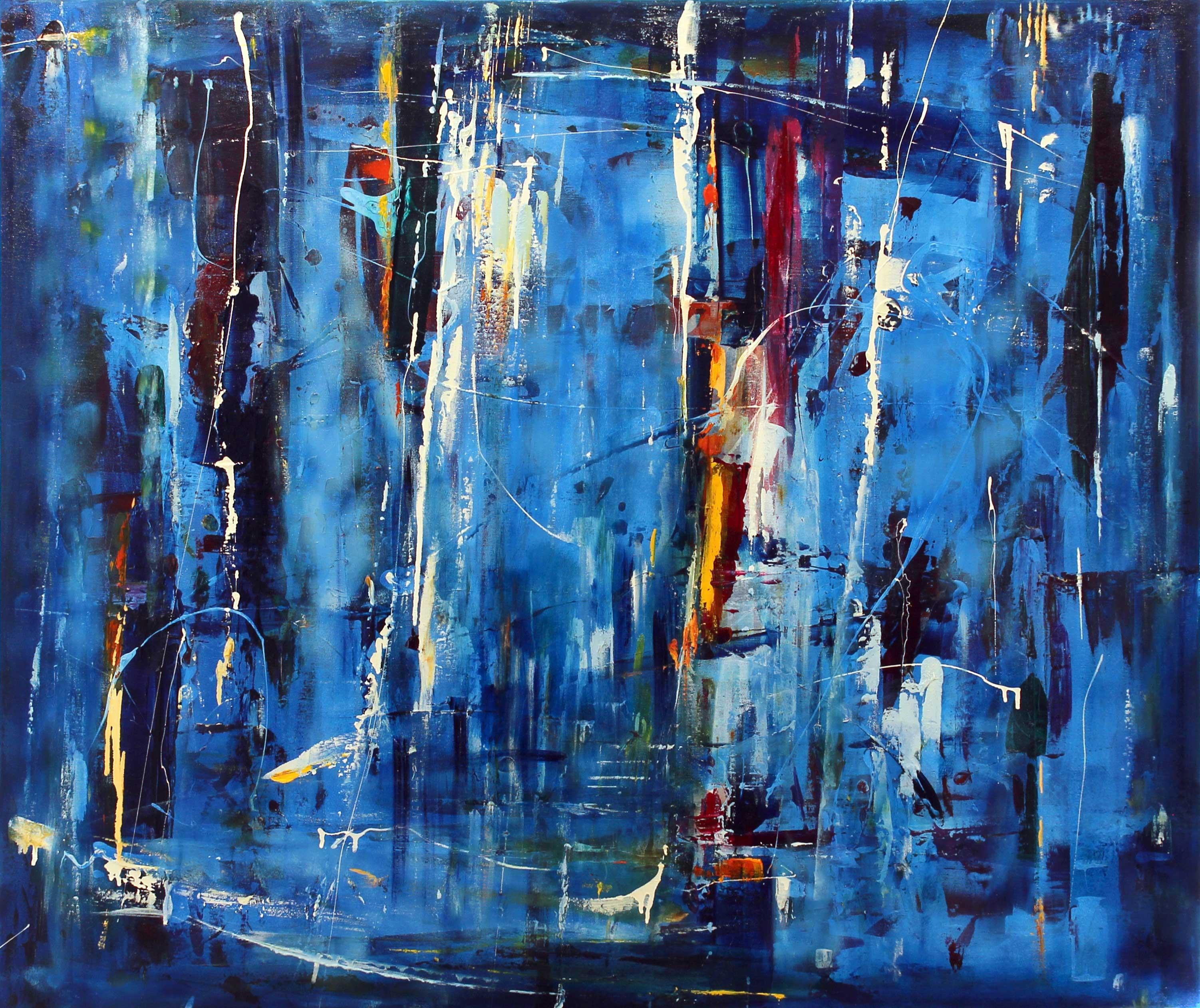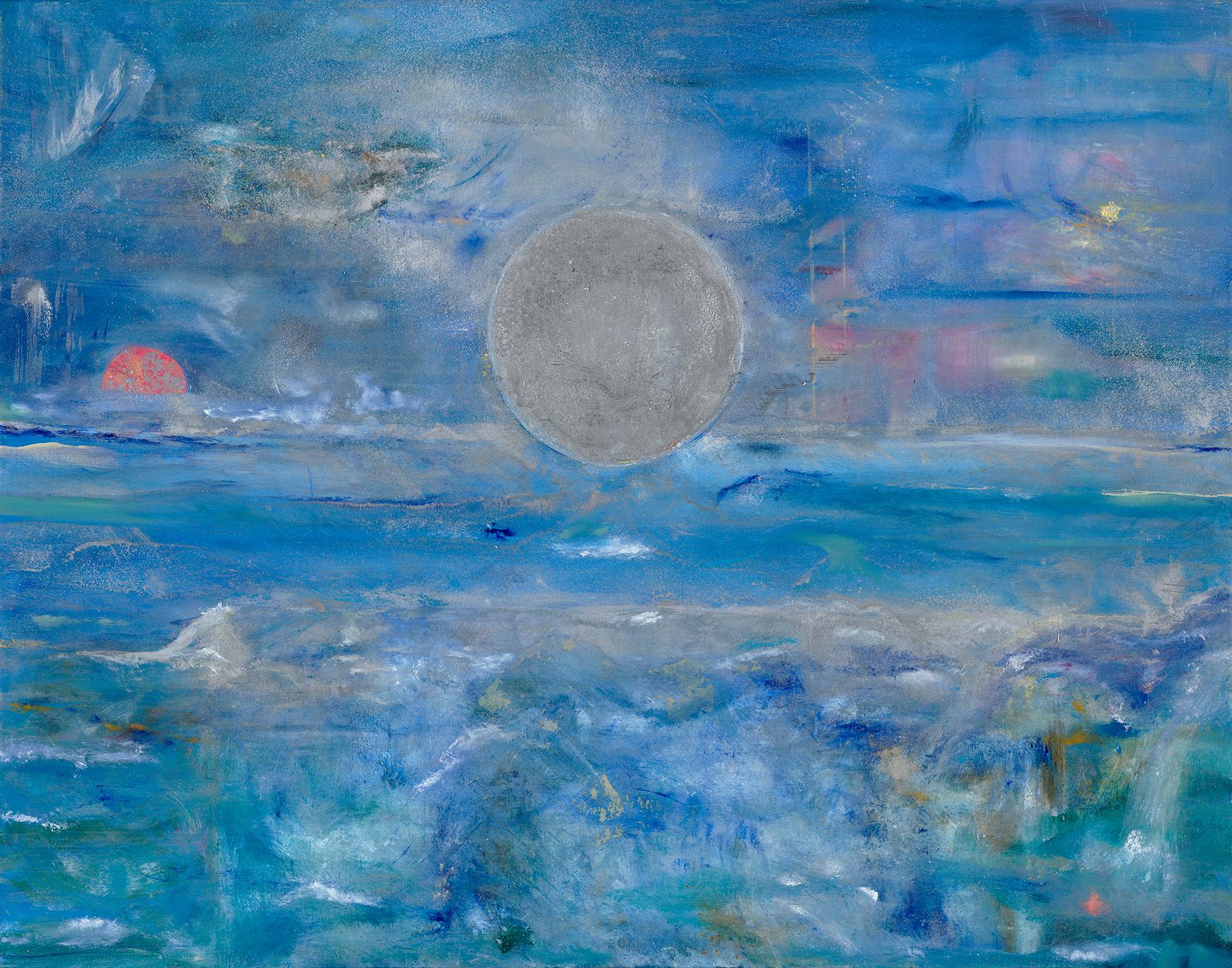Items Similar to Mid Century Modern Abstract Oil Painting by Werner Drewes, Green Blue Red Yellow
Video Loading
Want more images or videos?
Request additional images or videos from the seller
1 of 14
Werner DrewesMid Century Modern Abstract Oil Painting by Werner Drewes, Green Blue Red Yellow
About the Item
Abstract oil on canvas painting by Werner Drewes painted in vibrant shades of green, blue, and red from 1944. Signed by the artist in the lower right corner of the canvas. Presented in a custom white frame, outer dimensions measure 14 ¾ x 16 ¾ x 1 ¾ inches. Image size is 6 ½ x 8 ½ inches.
Expedited and international shipping is available - please contact us for a quote.
About the artist:
Educated by the foremost artists of the Bauhaus, Werner Drewes arrived in the United States in the early 1930s well-prepared to pass on his knowledge of art fundamentals and printmaking to students in New York and in the heartland. Introduced to the Connecticut art maven, Katherine Dreier, by his mentor Kandinsky, he had a number of exhibitions under the auspices of her Societe Anonyme. Quickly gaining many associates, he was a founding member of the American Abstract Artists, which was the first American organization to support artists pursuing this direction. An accomplished printmaker, Drewes’ experimentation in woodblock and intaglio marks his place in 20th-century art history and still inspires and instructs art students today.
The son of a Lutheran minister, Drewes began studying architecture and design in Stuttgart, after serving in World War I. He continued his studies at the Bauhaus, which was based on unifying aesthetic principles and their relation to universal dynamics. Organized by the concept of a workshop, the Bauhaus encouraged individual expression of these principles, so that its members, such as Klee, Schlemmer, and Itten, had distinctive styles. The “father” of the Bauhaus, Walter Gropius, identified Drewes talent as a printmaker, an art which combined technical proficiency with an eye for design. Given a room for the large printing press, Drewes learned in a setting which granted equal status to this artform, which was appreciated for its direct, deep-rooted expression.
In 1923, he began a period of world travel, starting with a tour of Europe and study of the Old Masters. After getting married in Italy, he and his wife continued on to South and Central America, then the United States, Korea, Japan, Manchuria, and Russia. When he returned to Germany in 1927, he resumed his studies at the Bauhaus, now located at Dessau. Feeling an affinity with the handicraft of non-Western artists, he felt alienated from the increasing industrial advocacy of the program. In his later years, he would state that his purpose was to “search for unknown worlds,” an impulse for exploration that characterizes his entire life and his life-in-art.
As many of the “outsider” artists of the Bauhaus, Drewes felt compelled to leave Hitler’s Germany. Arriving in New York in 1930, he supported himself with his prints, with his woodblocks of skyscrapers considered the first such of a modern city. From 1934 to 1936, he taught drawing and printmaking at the Brooklyn Museum School (with a later stint in 1944) and then served on the Columbia University faculty from 1937 to 1940. Most notably, Drewes was granted oversight of the Graphic Arts division of the WPA in New York from 1940 to 1941.
As an artist, he moved easily from representation art to abstraction. As a Bauhaus student, he translated the world into visible form into its composites, which then became the building blocks for artistic interpretation. Drewes paid heed to the “laws of the Universe” but felt that art “has its own laws”: “To create new universes within these laws and to fill them then with the experiences of our own life is our task…When they convincingly reflect the vision or struggle of the soul, a work of art is born.”
Drewes was a founding member of the American Abstract Artists, an organization which included Josef Albers, Piet Mondrian, and Ferdinand Leger among others. His own approach to abstraction included both biomorphic and geometric shapes reminiscent of Klee and Kandinsky. His grounding in printmaking brought a sharp punctuation to his bright color choices, such that that tonal juxtaposition had an on-off quality typical of woodblock. At the same time, his woodblocks incorporated a nuanced and subtle tonal range and color selection not associated with the German tradition. While a member of Stanley William Hayter’s Atelier 17 in the forties, Drewes experimented with intaglio printmaking, and his interest in the technique fostered a renewed interest among American artists.
Invited by his old friend Lazlo Moholy-Nagy, Drewes went to teach at Chicago’s Institute of Design in 1944. This was soon followed by appointment to the faculty at the School of Fine Arts at Washington University in St.Louis, where he became a part of a circle of artist friends that included Max Beckmann, Philip Guston, and Carl Holty. His tenure there helped secure the foundation of Bauhaus-based abstraction in this country.
©David Cook Galleries, LLC
- Creator:Werner Drewes (1899-1985, American)
- Dimensions:Height: 14.75 in (37.47 cm)Width: 16.75 in (42.55 cm)Depth: 1.75 in (4.45 cm)
- Medium:
- Movement & Style:
- Period:
- Condition:very good to excellent condition.
- Gallery Location:Denver, CO
- Reference Number:
About the Seller
5.0
Platinum Seller
These expertly vetted sellers are 1stDibs' most experienced sellers and are rated highest by our customers.
Established in 1979
1stDibs seller since 2013
264 sales on 1stDibs
Typical response time: 5 hours
- ShippingRetrieving quote...Ships From: Denver, CO
- Return PolicyA return for this item may be initiated within 7 days of delivery.
More From This SellerView All
- 1950s Abstract Expressionist Oil Painting, Blue Brown Orange Sage GreenBy Charles Ragland BunnellLocated in Denver, COAbstract expressionist oil painting on board from 1955 by Charles Bunnell. Abstract shapes in layers of sage green, light blue, brown, gold, and black. Presented in a custom frame, o...Category
1950s Abstract Expressionist Abstract Paintings
MaterialsBoard, Oil
- Crystal, Series #3 Ros, 1960 Abstract Collage Painting in Purple & Pink TonesBy Margo HoffLocated in Denver, COMid-century modern abstract painting of crystal formations by Margo Hoff (1910-2008) created with acrylic and canvas collage in purple and pink coloring. Wrapped canvas is ready to hang, outer dimensions measure 49 x 49 x 1 ¼ inches. Provenance: Estate of the Artist, Margo Hoff About the Artist: Born Oklahoma 1910 Died New York 2008 A prolific artist, Margo Hoff’s exquisite style evolved throughout her career yet was always rooted in the events, people, and places in her life. The human experience was her sole focus, expressed through her eyes alone. Born in 1910 in Tulsa, Oklahoma, Hoff began creating white-clay animals at a young age, giving them to her friends and family. At eleven she contracted typhoid fever and was bedridden for a summer. During her convalescence, she drew and made cutouts, and it was during this time that her bold, artistic imagination came alive. She began formal art training in high school and continued her education at the University of Oklahoma, Tulsa. In 1933 she moved to Chicago and attended the National Academy of Art and the School of the Art Institute of Chicago. Between 1933 and 1960—her Chicago years—Hoff’s works was deeply rooted in a figurative, regionalist style. She often used elements of magical realism, and many of her paintings have dreamlike qualities. As a child she learned about color by grinding down rocks, plants, and berries. Her color pallet during the Chicago years is indicative of her early-life color experimentation as she consistently used warm, earth tones in her work. Hoff was a born adventurer and traveled extensively. She lived, worked, taught, and painted in Europe, Mexico, Lebanon, Uganda, Brazil, and China. She also showed at the Denver Art Museum’s Annual Western Exhibitions in 1952-54, 56, and 57. In 1957 she showed along side Colorado modernist Vance Kirkland at the Denver Art Museum’s exhibition, Man's Conquest of Space. What was once a focus on the representational, her work began to change after 1957 when she saw Sputnik in its orbit around Earth. At that moment, feet firmly placed on the ground, she was able to imagine herself in space, looking down from the cosmos, and what she saw was an abstracted world. She then had the opportunity to peer into an electron microscope where once again she was looking down into what seemed to be a realm of pure abstraction. These two events profoundly changed her perspective and she began to move from figural painting to abstract, geometric collage. In 1960, Hoff moved to New York City and she began creating collages. Placing the canvas on the ground, and working from all sides, she used strips of painted paper and tissue—and later painted pieces of canvas—glued onto the canvas surface, building layer upon layer, shape against shape, “action of color next to stillness of color.” She believed these simplified, abstracted forms held the spirit of the subject in the same way poetry reduces words to their essence. These pieces range from aerial cityscapes, to dancers in motions, to flora...Category
1960s Abstract Expressionist Paintings
MaterialsAcrylic, Mixed Media, Canvas, Oil
- 1950s Framed Abstract Expressionist Oil Painting, Mid Century Modern, Green RedBy Charles Ragland BunnellLocated in Denver, COVintage 1950s mid century modern abstract expressionist painting by Colorado artist, Charles Ragland Bunnell in shades of red, green, white, and black. Presented in the artist's orig...Category
1950s Abstract Expressionist Abstract Paintings
MaterialsOil, Wood
- 1950s Abstract Oil Painting, Framed Mid Century Modern Painting Blue Black WhiteBy Paul Kauver SmithLocated in Denver, COOriginal oil painting by mid-century modernist Paul K. Smith (1893-1977). Painted in a soft gray, blue, ivory, brown and black with subtle under layers of oran...Category
Mid-20th Century Abstract Expressionist Abstract Paintings
MaterialsOil
- 1950s Abstract Expressionist Composition, Mid Century Oil Painting, Blue YellowBy Charles Ragland BunnellLocated in Denver, COOriginal 1958 mid-century modern oil painting by Charles Bunnell (1897-1968), abstract expressionist composition in colors of Yellow, Blue, Teal, Green, Gray, Orange, Red & White, signed and dated lower right. Presented in a vintage gold tone frame, outer dimensions measure 34 ¾ x 28 ¾ x 1 ½ inches. Image size is 29 ¾ x 23 ¾ inches. Painting is clean and in very good vintage condition - please contact us for a complete condition report. Provenance: Estate of Charles Ragland Bunnell Expedited and international shipping is available - please contact us for a quote. About the Artist: Charles Bunnell developed a love for art as a child in Kansas City, Missouri. Around 1915, Bunnell moved with his family to Colorado Springs, Colorado. He served in World War I and later used his GI Training to study at the Broadmoor Art Academy (later renamed the Colorado Springs Fine Arts Center) during 1922 and 1923. In 1922, he married fellow student, Laura Palmer...Category
1950s Abstract Expressionist Abstract Paintings
MaterialsOil, Board
- Composition in Red and Blue - Abstract Expressionist 1950s Oil PaintingBy Charles Ragland BunnellLocated in Denver, CO'Composition in Red and Blue' is a vintage abstract expressionist original oil painting on board by Charles Bunnell (1897-1968) from 1951. Signed and dated by the artist in the lower left corner. Abstract composition painted in shades of white, cream, blue, red, and tan. Presented in a vintage frame, outer dimensions measure 28 ½ x 22 ½ x 1 inches. Image size is 24 x 18 inches. About the Artist: Charles Bunnell developed a love for art at a very young age. As a child in Kansas City, Missouri, he spent much of his time drawing. When he was unable to find paper he drew on walls and in the margins of textbooks for which he was often fined. Around 1915, Bunnell moved with his family to Colorado Springs, Colorado. He served in World War I and later used his GI Training to study at the Broadmoor Art Academy (later renamed the Colorado Springs Fine Arts Center) during 1922 and 1923. In 1922, he married fellow student, Laura Palmer. He studied with Ernest Lawson in 1927-1928 and, in the winter of 1928-1929, he served as Lawson’s assistant. In the late 1920’s, the Bunnell’s settled just west of Colorado Springs and 1928, they welcomed the first of their three children. Their one-acre homesite, which they referred to as “Old Home Place”, was situated between two sets of railroad tracks at the foot of Pike’s Peak. Charlie converted an old railroad boxcar into his studio, where he later gave lessons. Beginning in 1931, Bunnell spent a year and a half studying under Boardman Robinson. The two men clashed constantly due to a generation gap and markedly different philosophies. Robinson encouraged his students not to stray from realism and though Bunnell mastered Robinson’s preferred style of American Scene painting, he regularly irritated his professor with his abstract sketches. Bunnell taught at the Kansas City Art Institute during the summers of 1929, 1930, 1940, and 1941. Between 1934 and 1941, he painted and taught under federal projects which included assisting Frank Mechau on murals for the Colorado Springs Post Office. However, he did not take to mural making and, after criticism from Boardman Robinson about his use of “heavy daubs which have no place in mural work,” he abandoned mural-making altogether. By the late 1930’s, Bunnell’s work departed from the American Scene/Modernist style he was trained in towards abstraction. This is marked by his “Black and Blue” series, consisting of 83 abstracted ink and watercolors. Affected by the Second World War and the loss of his 10-year old son, Bunnell’s work of the early 1940’s took on a Transcendental and Surrealist tone. The works from this period are moody and readily reflect the political and personal turmoil experienced by the artist. In the late 1940’s, Bunnell began experimenting with Abstract Expressionism. He alone is credited with introducing Colorado Springs to the new style as it was excluded from the Fine Art Center’s curriculum by Boardman Robinson. Bunnell excelled in Abstract Expressionism and continued to evolve in the style through the 1950’s continuing to his death in 1968. He was recently recognized as a premier American Abstract Expressionist by his inclusion in the book American Abstract Expressionism of the 1950’s: An Illustrated Survey. Solo Exhibits: Kansas City Art Institute, Kansas City, Missouri, 1930; Santa Fe Museum, Santa Fe, New Mexico, 1947; University of Illinois, Urbana, Illinois, 1948; University of Kentucky, Lexington, Kentucky, 1949; Taos Gallery, Taos, New Mexico, 1951; Carl Barnett Galleries, Dallas, Texas, 1952; The Bodley Gallery, New York, 1955; Amarillo, Texas, 1955; Haigh Gallery, Denver, Colorado, 1955; Colorado Springs Fine Arts Center, Colorado Springs, Colorado, 1956; Dord Fitz Art Gallery, Amarillo, Texas, December 1956 – February 1957, 1959, 1969 (retrospective). Group Exhibits: Carnegie Institute, 1927-1928; Colorado State Fair, 1928 (1st prize); Artists Midwestern, Kansas City, Missouri, 1929 (Gold Medal); Art Institute of Chicago, 1947 (the exhibit traveled to ten major museums in the United States); “Artists West of the Mississippi”, Colorado Springs Fine Arts Center, Colorado Springs, Colorado (7 times); Denver Art Museum Western Annual, Denver, Colorado (5 times); Mid-America Annual, Kansas City, Missouri, 1958; First Provincetown Festival, 1958; Southwestern Annual, Santa Fe, New Mexico, Winter 1957-1958; Central City, Colorado; Cañon City...Category
1950s Abstract Expressionist Abstract Paintings
MaterialsCanvas, Oil
You May Also Like
- DaydreamsLocated in Southampton, NYPart of a new collection of painted porcelain panels by Chinese artist Yuan Lin, “Daydreams” is a luminous meditation on the sun's rays. In this painting, Lin...Category
2010s Abstract Expressionist Abstract Paintings
MaterialsCeramic, Glaze, Oil
- Mindy Weisel, Not Everything is Black and White , 2017 oil on canvas 91 x 91By Mindy WeiselLocated in Jerusalem, ILMindy Weisel Not Everything is Black and White , 2017 oil on canvas 91 x 91 cm 36 x 36 in Exhibited Mindy Weisel "Meditations on Love", Rosenbach Conte...Category
2010s Abstract Expressionist Abstract Paintings
MaterialsCanvas, Oil
- Binyamin Basteker, The sounds of flowers (Jerusalem flower series) oil on canvasLocated in Jerusalem, ILBinyamin Basteker The sounds of flowers , 2020 oil on canvas 80 x 60 cm 31 x 24 in Exhibited: "Jerusalem Flowers", 2020 Rosenbach Contemporary, Jerusalem Binyamin Basteker was bo...Category
2010s Abstract Expressionist Abstract Paintings
MaterialsOil
- Binyamin Basteker First rain in Jerusalem , 2018 oil on canvas 100 x 120 cmLocated in Jerusalem, ILBinyamin Basteker First rain in Jerusalem , 2018 oil on canvas 100 x 120 cm 39 x 47 in As a student of the masterful colorists of India and the Israeli abstract masters of the 1970s, Basteker has developed a unique style of painting. He loves color, he loves abstract and he loves the holy city...Category
2010s Abstract Expressionist Abstract Paintings
MaterialsOil
- Jacob's Ladder, 2021 oil on canvas oil on canvas 110 x 140 cm (43 x 55 in)By Raquel SanchezLocated in Jerusalem, ILRaquel Sanchez Jacob's Ladder , 2021 oil on canvas 110 x 140 cm (43 x 55 in) Exhibited: Jerusalem Biennale 2021 Influenced by the Impressionist and Modern masters, Raquel's perso...Category
2010s Abstract Expressionist Abstract Paintings
MaterialsOil
- Binyamin Basteker, Abstract composition , 1990 oil on canvas 87 x 115 cmLocated in Jerusalem, ILBinyamin Basteker Abstract composition , 1990 oil on canvas 87 x 115 cm 34 x 45 in Binyamin Basteker was born in Mumbai in 1953. Growing up in a family of artists, his unique tal...Category
1980s Abstract Expressionist Abstract Paintings
MaterialsOil
Recently Viewed
View AllMore Ways To Browse
Green Blue Red
Europe Mid Century Paintings
Used American Drew
American Drew
Mid Century Italian Abstract
Large Mid Century Modern Paintings
Mid Century Modern Abstract Oil
Mid Century Modern Abstract Oil Paintings
Large Painting And Midcentury Modern
Unknown Mid Century Modern Abstract
Japanese Mid Century Painting
Blue Painting Mid Century Modern
Mid Century Block Art
Modern Gropius
Large Mid Century Modern Abstract Paintings
Gropius Mid Century Modern
Large Mid Century Modern Oil Paintings
German Paintings 1930s





